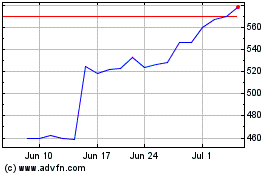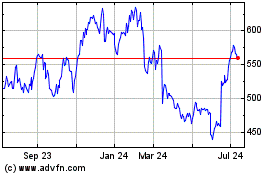It is Time to Get Flash Off Your Computer
May 17 2016 - 2:28PM
Dow Jones News
By Nathan Olivarez-Giles
Alphabet Inc.'s Google is taking a major step in its long,
drawn-out breakup with Flash.
By the end of the year, Google's Chrome browser for Macs,
Windows-based PCs and Chromebooks will render rich media such as
videos and animated graphics in HTML 5 by default, instead of using
Adobe Systems Inc.'s long-maligned software. It is the latest step
from the likes of Google, Apple Inc., Facebook Inc. and others to
embrace HTML 5, a set of technologies developed by an open, global
community of programmers.
Calls to abandon Flash have been around for years. Now, HTML 5
is developed enough that you can heed the call. Here's a guide to
help you walk away.
The problems with Flash
The major complaints against Flash today are no different than
in 2010, when Apple Chief Executive Steve Jobs said security
issues, battery drain, poor performance and Adobe's proprietary
control would keep Flash off iPhones, iPads and iPods.
Flash is a common way PC users run into malware. Last year,
Chrome and Mozilla's Firefox browser temporarily blocked the
software over security vulnerabilities. Adobe issued a software
fix, but later in the year Chrome began automatically pausing Flash
video ads because of performance issues.
Facebook security chief Alex Stamos called on Adobe to stop
trying to fix Flash and end support outright.
How Chrome users are affected
Google isn't entirely ditching Flash. Adobe's software will
remain an option for Chrome -- the most widely used browser on
desktops and laptops -- but you will have to opt in on a
per-website basis. "If a site truly requires Flash, a prompt will
appear at the top of the page when the user first visits that site,
giving them the option of allowing it to run for that site,"
Anthony LaForge, a technical program manager on the Chrome team,
said in a note to developers explaining the changes.
Chrome's prompt will ask for permission to run Flash. If
permission is granted, Chrome will offer three choices: "run once,"
"run always" or "never ask again."
If a site gives Chrome the option of rendering an object using
HTML 5 or Flash, Chrome will choose HTML 5, Mr. LaForge said.
YouTube already defaults to HTML 5, for example.
Google is making exceptions
Google plans to bend its new rules. The 10 most popular sites
still using Flash (as determined by Google's internal metrics)
won't trigger the opt-in prompt for at least a year. Instead, the
companies running those sites will get to choose the experience for
users.
Google is making this exception "to reduce the initial user
impact, and avoid over-prompting," the company said. Those 10 sites
are YouTube.com, Facebook.com, Yahoo.com, VK.com, Live.com,
Yandex.ru, OK.ru, Twitch.tv, Amazon.com and Mail.ru, the company
said.
Adobe's position
In 2011, Adobe killed a smartphone version of Flash that never
caught on. In November, Adobe changed the name of the software
required to make Flash media from Flash Professional to Animate CC.
At the same time, it shifted the focus of the application from
Flash development to creating media in HTML 5 and other open
formats.
Adobe intends to continue supporting Flash given its widespread
use in education, Web gaming and premium video. But it is
encouraging "content creators to build with new Web standards," the
company told the Journal.
What you can do now
Adobe is walking away from Flash. You should too. There is no
mobile version of the software, so when you're using an iPhone,
iPad or Android device, you aren't using Flash. You probably don't
miss it.
If you use a Windows-based PC, you can remove Flash by going to
your PC's control panel and calling up "programs and features."
Uninstall Adobe Flash Player like any other app. If you use a Mac,
download and use the uninstaller app Adobe makes specifically for
this purpose.
Write to Nathan Olivarez-Giles at
Nathan.Olivarez-giles@wsj.com
(END) Dow Jones Newswires
May 17, 2016 14:13 ET (18:13 GMT)
Copyright (c) 2016 Dow Jones & Company, Inc.
Adobe (NASDAQ:ADBE)
Historical Stock Chart
From Mar 2024 to Apr 2024

Adobe (NASDAQ:ADBE)
Historical Stock Chart
From Apr 2023 to Apr 2024
